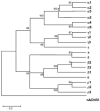International Union of Pharmacology. LXX. Subtypes of gamma-aminobutyric acid(A) receptors: classification on the basis of subunit composition, pharmacology, and function. Update
- PMID: 18790874
- PMCID: PMC2847512
- DOI: 10.1124/pr.108.00505
International Union of Pharmacology. LXX. Subtypes of gamma-aminobutyric acid(A) receptors: classification on the basis of subunit composition, pharmacology, and function. Update
Abstract
In this review we attempt to summarize experimental evidence on the existence of defined native GABA(A) receptor subtypes and to produce a list of receptors that actually seem to exist according to current knowledge. This will serve to update the most recent classification of GABA(A) receptors (Pharmacol Rev 50:291-313, 1998) approved by the Nomenclature Committee of the International Union of Pharmacology. GABA(A) receptors are chloride channels that mediate the major form of fast inhibitory neurotransmission in the central nervous system. They are members of the Cys-loop pentameric ligand-gated ion channel (LGIC) superfamily and share structural and functional homology with other members of that family. GABA(A) receptors are assembled from a family of 19 homologous subunit gene products and form numerous, mostly hetero-oligomeric, pentamers. Such receptor subtypes with properties that depend on subunit composition vary in topography and ontogeny, in cellular and subcellular localization, in their role in brain circuits and behaviors, in their mechanisms of regulation, and in their pharmacology. We propose several criteria, which can be applied to all the members of the LGIC superfamily, for including a receptor subtype on a list of native hetero-oligomeric subtypes. With these criteria, we develop a working GABA(A) receptor list, which currently includes 26 members, but will undoubtedly be modified and grow as information expands. The list is divided into three categories of native receptor subtypes: "identified," "existence with high probability," and "tentative."
Figures


References
-
- Atack JR. The benzodiazepine binding site of GABAA receptors as a target for the development of novel anxiolytics. Expert Opin Investig Drugs. 2005;14:601–618. - PubMed
-
- Atack JR, Wafford KA, Tye SJ, Cook SM, Sohal B, Pike A, Sur C, Melillo D, Bristow L, Bromidge F, et al. TPA [7-(1,1-dimethyl)-6-(2-ethyl-2H-1,2,4-triazol-3-ylmethoxy)-3-(2-fluorophenyl)-1,2,4-triazolo[4,3-b]pyridazine], an agonist selective for α2- and α3-containing GABAA receptors, is a nonsedating anxiolytic in rodents and primates. J Pharmacol Exp Ther. 2006;316:410–422. - PubMed
-
- Bai D, Zhu G, Pennefather P, Jackson MF, MacDonald JF, Orser BA. Distinct functional and pharmacological properties of tonic and quantal inhibitory postsynaptic currents mediated by GABAA receptors in hippocampal neurons. Mol Pharmacol. 2001;59:814–824. - PubMed
-
- Barnard EA, Skolnick P, Olsen RW, Mohler H, Sieghart W, Biggio G, Braestrup C, Bateson AN, Langer SZ. International Union of Pharmacology. XV. Subtypes of γ-aminobutyric acidA receptors: classification on the basis of subunit structure and receptor function. Pharmacol Rev. 1998;50:291–313. - PubMed
-
- Barrera NP, Betts J, You H, Henderson RM, Martin IL, Dunn SMJ, Edwardson JM. Atomic force microscopy reveals the stoichiometry and subunit arrangement of the α4β3δ GABAA receptor. Mol Pharmacol. 2008;73:960–967. - PubMed
Publication types
MeSH terms
Substances
Grants and funding
LinkOut - more resources
Full Text Sources
Other Literature Sources
Molecular Biology Databases

